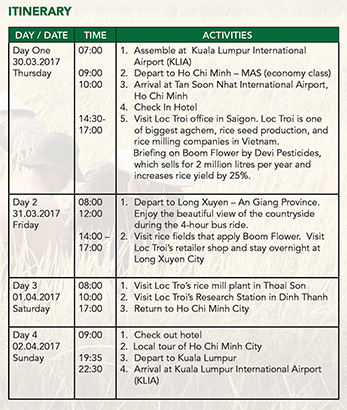Eleven officers from different government agencies in Malaysia visited the rice production areas and research centers in Mekong Delta, Vietnam on 10 March – 2 April 2017.
This technical visit aims to introduce officers from several agencies under the Malaysian Ministry of Agriculture and Agro-based Industry to rice production technologies and activities in Mekong Delta, Vietnam. Specifically, the participants will learn about rice production system by using Boom Flower technology, acquire current information on high yield production technology from rice research center in Vietnam; and gain technical-know-how and experiences on rice Integrated Farm Management System in Mekong Delta.

Rice is one of the most important staples for more than half of the world’s population, impacting livelihoods and economies of several billion. In 2014, Southeast Asia accounted for 28% of global rice production. Average annual consumption per capita of rice in Southeast Asia is more than 100 kg, providing 49% of calories and 39% of protein in the diet. Rice is so important in Southeast Asian cultures that it is a subject of economic policies, a foundation of national objectives, and a cornerstone of political stability.
Indonesia is the largest producer of rice in the region, followed by Vietnam and Thailand. Thailand is the biggest exporter of rice in the world, followed by Vietnam. Meanwhile, Malaysia has one of the lowest production of rice in the region.
The Mekong Delta, also known as the “Rice Bowl” of Vietnam is crucial to the production of rice in the country. Twelve provinces constitute the Mekong Delta, which houses about 17 million people and 80% are employed in rice cultivation. Yields are very high, reaching an average of 6.33 tonnes per hectare.
In Malaysia, rice yield in 2014 averages at 3.8 tonnes per hectare. Cost of production is also high. In 2015, self-sufficiency in Malaysia is about 71%.

